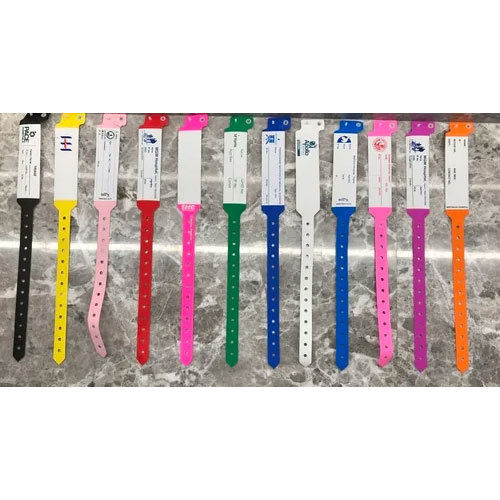A Comprehensive Overview to Patient Identification Band as a Vital Medical Supply
In the substantial landscape of health care, Patient Identification bands have actually become a vital tool (patient identification band). These bands, overflowing with vital data, function as the initial line of defense versus medical mistakes and make sure seamless Patient treatment. As we begin to explore these medical products detailed, we uncover the complexities of their design, use, and effect on Patient safety and security, while hinting at the pledge they hold for future medical techniques
The Function of Patient Identification Bands in Medical Care
The significance of Patient Identification bands in medical care can not be overemphasized. These straightforward wristbands offer as the main technique of ensuring Patient identification, reducing the danger of clinical mistakes and boosting total Patient safety. Patient Identification bands supply a system of checks and equilibriums, a fail-safe against possible errors, and a consistent pointer of the individual behind the therapy.
Decoding the Details on Patient Identification Bands
While they may appear easy at a glance, Patient Identification bands lug essential details that can greatly impact the program of a person's care. These bands commonly display the Patient's name, day of birth, and a special identifier, such as a clinical record number. Furthermore, the barcode found on these bands can be scanned to access the Patient's digital health record, supplying a riches of information to medical care providers.
Various Types of Patient Identification Bands: A Closer Appearance
In the world of Patient Identification, there are several types of bands that offer distinct functions. Barcode Identification Bands, RFID Tag-based Bands, and Color-Coded Patient Bands are the key groups - patient identification band. Each type provides one-of-a-kind attributes and advantages, which will certainly be taken a look at in the adhering to sections
Barcode Identification Bands
Providing a considerable renovation in Patient safety and security, barcode Identification bands have come to be an important instrument in the clinical field. These bands shop important Patient information in a barcode format that's swiftly obtainable with a scan. This lowers the opportunity of human error in Patient Identification and information access, which is vital in medical treatments. The barcode system makes information like Patient name, medical history, allergic reactions, and suggested drugs readily offered. This makes sure quick and correct Patient Identification, particularly in emergency situations where every 2nd matters. Barcode Identification bands are also easy to make use of, cost-effective and long lasting, making them a vital part of modern medical care. Significantly, these bands have significantly lowered medical errors and boosted Patient safety.
RFID Tag-based Bands
An additional cutting-edge approach in Patient Identification is making use of RFID Tag-based bands. These bands utilize Radio Regularity Identification (RFID) modern technology to provide a secure type of Patient Identification. Unlike barcodes, RFID tags can save far more details and can be reviewed without straight view. This means that health care experts can access crucial Patient information, also if the band is covered by garments or bed linen. Moreover, RFID tags can be reprogrammed with updated info as needed, enhancing their capability. However, these bands can be a lot more pricey than other types of Identification, and there are privacy concerns linked with the usage of RFID technology. Regardless of these obstacles, RFID tags use significant possibility for enhancing Patient safety and security and performance in healthcare.
Color-Coded Patient Bands
Color-coded Patient bands stand as an easy yet efficient tool in Patient Identification. These bands, widespread in clinics and healthcare facilities, use various colors to indicate different Patient threats, conditions or allergic reactions, making certain prompt recognition by health care professionals. Therefore, the color-coded Patient band system is an important part of Patient security and reliable healthcare shipment.

Use of Patient Identification Bands: Treatments and Protocols
In healthcare settings, making use of Patient Identification bands plays a crucial role in ensuring Patient safety and decreasing medical mistakes. These bands, typically made of resilient, hypoallergenic product, are connected to the Patient's wrist or ankle, showing important details such as name, day of birth, and an unique identifier. The procedure is commonly carried out during admission, with the informative post details double-checked for accuracy. For babies, bands are connected to both the baby and mother to stop mismatches. In senior care, two bands might be utilized for clients with mental deterioration to make sure correct Identification. Adhering to these protocols helps to prevent Patient misidentification, a forerunner to significant clinical mistakes. This practice is a testimony to the crucial nature of Identification bands in Patient care.
The Effect of Identification Bands on Patient Security
Identification bands play a crucial role in keeping Patient safety in healthcare setups. Their usage can dramatically decrease clinical errors by guaranteeing that the best Patient gets the proper therapy. These simple tools add to improving the quality of treatment by giving an additional layer of verification to Patient identities.
Minimizing Medical Errors
Patient Identification bands have actually arised as an important tool in dramatically lowering these mistakes. Most importantly, these bands make certain that every Patient is properly matched with their clinical records, tests, and treatments, thereby substantially minimizing the risk of clinical errors. By ensuring exact Patient Identification, these bands contribute to improved Patient security, building depend on and self-confidence in the medical care system.
Guaranteeing Correct Treatment
Securing Patient safety and security, Identification bands play a critical duty in making sure the proper administration of treatments. They supply an easy yet reliable technique for appropriately determining patients and matching them to their medical documents. This reduces the risk of therapy mistakes, especially in high-pressure circumstances where errors can have severe repercussions. These bands have essential details such as the Patient's name, date of birth, and one-of-a-kind Identification number. Consequently, go to my site they promote precise cross-referencing with digital health and wellness documents, prescription orders, and procedural routines. In repercussion, the possibility of misdiagnosis, medicine errors, or step-by-step mix-ups is considerably minimized. In significance, Patient Identification bands work as a critical safeguard in the health care setup, considerably adding to Patient safety and security and making sure proper therapy.

Enhancing Quality Treatment
While they may show up unimportant, patient Identification bands considerably boost the top quality of care supplied in healthcare settings. They are an essential tool in guaranteeing Patient safety because of their capability to give instant accessibility to important information. This includes the Patient's case history, allergic reactions, and present treatment plans. Utilizing these bands reduces the risk of clinical mistakes, such as wrong medicine administration or operations. Furthermore, they reinforce the personal link in between doctor and Patient, boosting depend on and communication. This simple, cost-efficient band therefore plays a necessary role in Patient security, dramatically influencing the general top quality of treatment. The adoption of Patient Identification bands is, for that reason, a needed step in all medical care atmospheres.
Exploring the Future of Patient Identification Bands in Clinical Technique

Conclusion
Patient Identification bands play a crucial role in healthcare, ensuring exact Patient Identification and lowering medical errors. As medical practices proceed to advance, Patient Identification bands will certainly continue to be an essential part of the health care system.
While they might appear easy at a glance, Patient Identification bands bring important information that pop over to these guys can substantially impact the training course of an individual's treatment.Color-coded Patient bands stand as a basic yet effective device in Patient Identification.In medical care setups, the use of Patient Identification bands plays a pivotal function in ensuring Patient safety and lowering clinical errors. In essence, Patient Identification bands offer as a crucial guard in the health care setting, dramatically adding to Patient safety and security and guaranteeing appropriate treatment.
Patient Identification bands play a vital function in medical care, making sure accurate Patient Identification and reducing clinical errors.